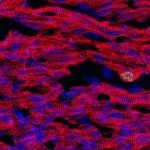Link to Pubmed [PMID] – 20466980
Link to DOI – 10.1161/CIRCRESAHA.110.218156
Circ Res 2010 Jul; 107(1): 153-61
The ventricular conduction system controls the propagation of electric activity through the heart to coordinate cardiac contraction. This system is composed of specialized cardiomyocytes organized in defined structures including central components and a peripheral Purkinje fiber network. How the mammalian ventricular conduction system is established during development remains controversial.To define the lineage relationship between cells of the murine ventricular conduction system and surrounding working myocytes.A retrospective clonal analysis using the alpha-cardiac actin(nlaacZ/+) mouse line was carried out in three week old hearts. Clusters of clonally related myocytes were screened for conductive cells using connexin40-driven enhanced green fluorescent protein expression. Two classes of clusters containing conductive cells were obtained. Mixed clusters, composed of conductive and working myocytes, reveal that both cell types develop from common progenitor cells, whereas smaller unmixed clusters, composed exclusively of conductive cells, show that proliferation continues after lineage restriction to the conduction system lineage. Differences in the working component of mixed clusters between the right and left ventricles reveal distinct progenitor cell histories in these cardiac compartments. These results are supported by genetic fate mapping using Cre recombinase revealing progressive restriction of connexin40-positive myocytes to a conductive fate.A biphasic mode of development, lineage restriction followed by limited outgrowth, underlies establishment of the mammalian ventricular conduction system.



